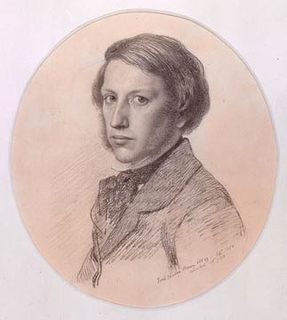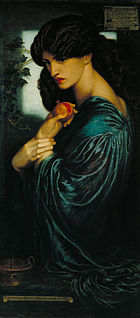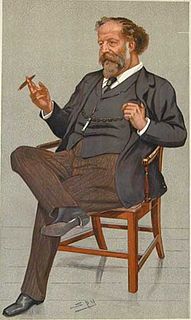
Ford Madox Brown was a British painter of moral and historical subjects, notable for his distinctively graphic and often Hogarthian version of the Pre-Raphaelite style. Arguably, his most notable painting was Work (1852–1865). Brown spent the latter years of his life painting the twelve works known as The Manchester Murals, depicting Mancunian history, for Manchester Town Hall.

The Pre-Raphaelite Brotherhood was a group of English painters, poets, and art critics, founded in 1848 by William Holman Hunt, John Everett Millais, Dante Gabriel Rossetti, William Michael Rossetti, James Collinson, Frederic George Stephens and Thomas Woolner who formed a seven-member "Brotherhood" modelled in part on the Nazarene movement. The Brotherhood was only ever a loose association and their principles were shared by other artists of the time, including Ford Madox Brown, Arthur Hughes and Marie Spartali Stillman. Later followers of the principles of the Brotherhood included Edward Burne-Jones, William Morris and John William Waterhouse.

Gabriel Charles Dante Rossetti, generally known as Dante Gabriel Rossetti, was an English poet, illustrator, painter and translator, and member of the Rossetti family. He founded the Pre-Raphaelite Brotherhood in 1848 with William Holman Hunt and John Everett Millais. Rossetti was later to be the main inspiration for a second generation of artists and writers influenced by the movement, most notably William Morris and Edward Burne-Jones. His work also influenced the European Symbolists and was a major precursor of the Aesthetic movement.

Sir Edward Coley Burne-Jones, 1st Baronet, was a British artist and designer associated with the phase of the Pre-Raphaelite movement, who worked with William Morris on decorative arts as a founding partner in Morris, Marshall, Faulkner & Co.

Henry Holiday was a British historical genre and landscape painter, stained-glass designer, illustrator and sculptor. He is part of the Pre-Raphaelite school of art.

The legacy of a family's passion for Victorian art and design, Wightwick Manor is a Victorian manor house located on Wightwick Bank, Wolverhampton, West Midlands, England. Owned by the National Trust since 1937, the Manor and its grounds are open to the public. It is one of only a few surviving examples of a house built and furnished under the influence of the Aesthetic movement and Arts and Crafts movement. The house is in a grand version of the half-timbered vernacular style, of which the most famous original example is Little Moreton Hall over 40 miles to the north, in Cheshire.

Red House is a significant Arts and Crafts building located in the town of Bexleyheath in Southeast London, England. Co-designed in 1859 by the architect Philip Webb and the designer William Morris, it was created to serve as a family home for the latter, with construction being completed in 1860.

Jane Morris was an English embroiderer in the Arts and Crafts movement and artists' model who embodied the Pre-Raphaelite ideal of beauty. She was a model and muse to her husband William Morris and to Dante Gabriel Rossetti. Her sister was embroiderer and teacher Elizabeth Burden.

Morris, Marshall, Faulkner & Co. (1861–1875) was a furnishings and decorative arts manufacturer and retailer founded by the artist and designer William Morris with friends from the Pre-Raphaelites. With its successor Morris & Co. (1875–1940) the firm's medieval-inspired aesthetic and respect for hand-craftsmanship and traditional textile arts had a profound influence on the decoration of churches and houses into the early 20th century.
Louis Davis was an English watercolourist, book illustrator and stained-glass artist. He was active in the Arts and Crafts Movement and Nikolaus Pevsner referred to him as the last of the Pre-Raphaelites.

A revival of the art and craft of stained-glass window manufacture took place in early 19th-century Britain, beginning with an armorial window created by Thomas Willement in 1811–12. The revival led to stained glass windows becoming such a common and popular form of coloured pictorial representation that many thousands of people, most of whom would never commission or purchase a painting, contributed to the commission and purchase of stained-glass windows for their parish church.

Joseph William Comyns Carr was an English drama and art critic, gallery director, author, poet, playwright and theatre manager.

The Church of St Martin is a 19th-century church in Marple, Greater Manchester, England.

St Olave's Church, Gatcombe is a parish church in the Church of England located in Gatcombe, Isle of Wight.

Cliffe Castle Museum, Keighley, West Yorkshire, England, is a local heritage museum which opened in the grand, Victorian, neo-Gothic Cliffe Castle in 1959. Originating as Cliffe Hall in 1828, the museum is the successor to Keighley Museum which opened in Eastwood House, Keighley, in c. 1892. There is a series of galleries dedicated to various aspects of local heritage, and to displaying the house itself, which is a Grade II listed building. Entrance to the museum is free of charge.

Waterford is a village in the East Hertfordshire district of Hertfordshire, England. It is located on the A119 road, around 2.5 km north of Hertford. The River Beane flows through the village. It is in the civil parish of Stapleford.

The Oxford Union murals (1857–1859) are a series of mural decorations in the Oxford Union library building. The series was executed by a team of Pre-Raphaelite artists including Dante Gabriel Rossetti, William Morris and Edward Burne-Jones. The paintings depict scenes from Arthurian myth.

Peter Paul Marshall was a Scottish civil engineer and amateur painter, and a founding partner of the decorative arts firm Morris, Marshall, Faulkner & Co.

Love and the Maiden is a tempera on canvas by English Pre-Raphaelite artist John Roddam Spencer Stanhope, executed in 1877 and currently housed at the Fine Arts Museums of San Francisco.

The Sacred Heart RC Church is a Roman Catholic church and ecclesiastical parish in North Gosforth, Newcastle upon Tyne. It is part of the Roman Catholic Diocese of Hexham and Newcastle. Situated between Wideopen village to the north and Gosforth Park to the south, the church was made a Grade II listed building in 2006. It is notable for its stained glass windows bearing designs by members of the Pre-Raphaelite Brotherhood, in particular Sir Edward Burne-Jones.




















